Sketches for the "Augurs of Spring"
Page 3 of the sketchbook of The Rite , reproduced in Figure 3 and transcribed in Example 58, consists of nine entries for the beginning of the "Augurs of Spring." At first glance it would appear that the fifth and sixth lines at the bottom of this page, each with four staves, were composed as a single entry. However, if these lines are read as a continuation of the fourth line directly above (where the "Augurs of Spring" or "motto" chord first appears), then the last three lines constitute, in proper succession, a remarkably accurate account of nos. 13–17 of the score. (Observe that the accentual pattern of the repeated chord, eight measures in length, is fully realized. The score itself extends, at the end of the fourth line, the D




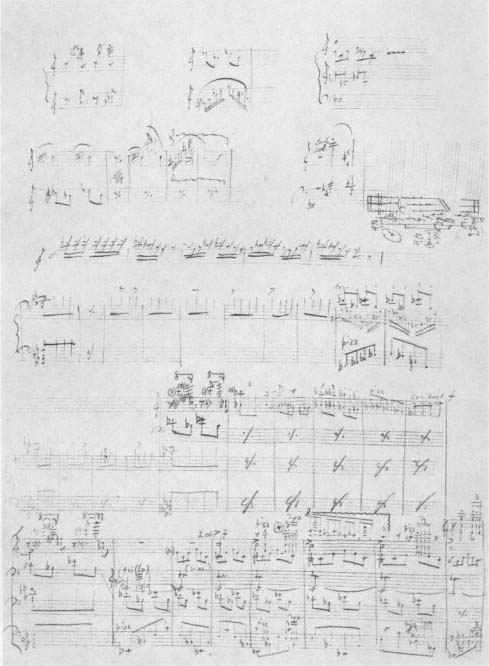
Figure 3:
Early jottings and sketches for the "Augurs of Spring," page 3 of the sketchbook of The Rite.
The Rite of Spring (Le Sacre du Printemps) Sketches , 1911–1913 ,© copyright 1969
Boosey & Hawkes Music Publishers Ltd. Reprinted by permission of Boosey & Hawkes, Inc.
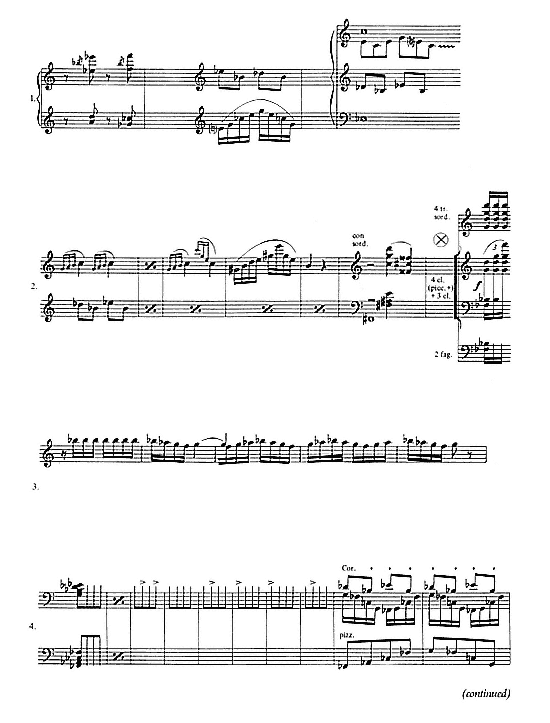
Example 58:
Sketchbook, p. 3 ("Augurs of Spring")
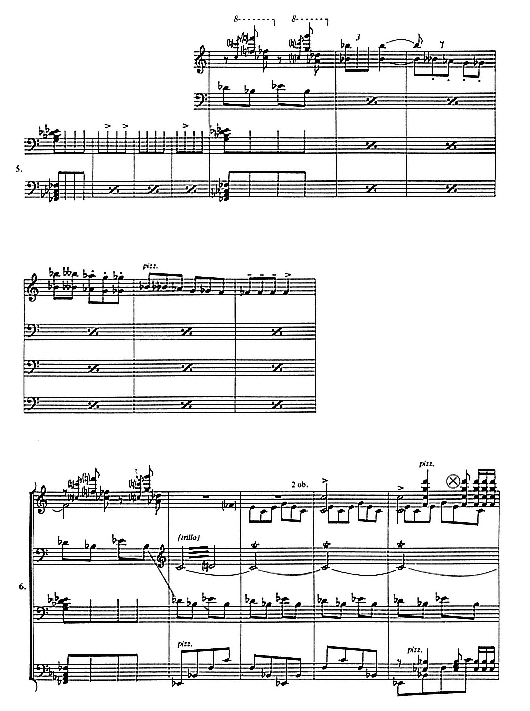
Example 58
(continued)
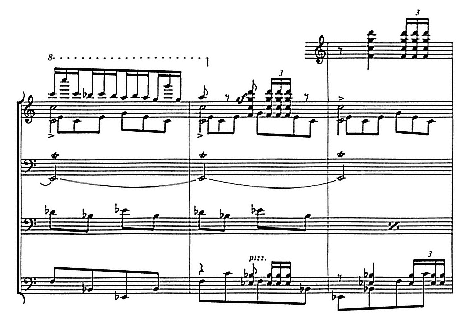
Example 58
(continued)
In his commentary to the sketchbook, Robert Craft has remarked that such details were unusual at so early a stage in the conception of a Stravinsky work.[1]
Pages 5 and 6 are likewise ostensibly devoted to the "Augurs of Spring." They include a sketch for the "break" at no. 22, entries for the new horn melody at no. 25, and a brief jotting at the bottom of page 5 for the transition or "modulation" at no. 30. Most elaborate, however, is a six-stave sketch at the top of page 6 for the beginning of the first climactic block at nos. 28–30. The latter even includes the melody, introduced by the trumpets at no. 28+4 of the score, that would subsequently serve as the principal motive of the "Spring Rounds." Following its appearance at the top of page 6, the succeeding material of pages 7–9 is in fact given almost entirely to the "Spring Rounds." (Recall that this was the original order of the dances: "Spring Rounds" followed the "Augurs of Spring," while the "Ritual of Abduction" came after the "Rival Tribes" and its succeeding "Procession." According to Craft, the "Spring Rounds" melody was one of Stravinsky's earliest ideas.)[2] The sketches for the "Augurs of Spring" on pages 3–6 underscore the prin-
[1] Robert Craft, "Commentary to the Sketches," Appendix I in the accompanying booklet to Igor Stravinsky, The Rite of Spring: Sketches 1911–1913 (London: Boosey and Hawkes, 1969), p. 4.
[2] Ibid., p. 6.
cipal divisions of this movement as a whole. At the end of the Introduction there is a brief preparation or transition at no. 12. This is followed at nos. 13–22 by Section I, where the motto chord is first introduced, and then at nos. 22–30 by Section II, where two new melodies appear and the motto chord is dropped. Finally, the transition or "modulation" at no. 30 leads to Section III at nos. 31–37, the final climactic block of the "Augurs of Spring."
Somewhat puzzling in relation to the extended sketch are the initial jottings at the top of page 3. Not that the relationship of these entries to the "Augurs of Spring" at nos. 13–22 is in any way obscured. Except for the second line's second entry, where the chords are part of the Introduction's preparatory block at no. 12, all entries refer unambiguously to the extended sketch on pages 3–5. Puzzling, rather, is the immediacy of some of these jottings compared to the surprising gaps evidenced by others. The third notation of the first line is an accurate spelling of m.3 of the last line. On the other hand, the first entry's syncopated offbeat figure is inaccurate, down a whole step from its pitch at m.5 in the fifth line.[3] And the (B





All these jottings were undoubtedly composed in preparation for what follows below. Yet the extended sketch, in its overall comprehension and detail, exhibits such a stunning command of the "Augurs of Spring" at nos. 13–22 that the discrepancies revealed by some of these entries are not easily reconciled. Irrespective of whether pages 3–5 do comprise Stravinsky's first notations for the "Augurs of Spring," it is tempting to suppose that the extended sketch had been with the composer for some time prior to actual notation and that the prefatory jottings on page 3 were entered as "soundings" with a preexistent view toward the more precise plan of action detailed below.
Noteworthy in this respect are the sketchbook's initial entries for the "Glorification of the Chosen One" on pages 52, 59, 61, and 66–67 and those for the "Sacrificial Dance" on pages 84–85. These, as noted in Chapter 2, reveal a similarly developed character. And the role of the piano in Stravinsky's inventive processes, early on as an aid in improvisation and then in a constant "testing" of the ear, cannot sufficiently be stressed. Notice, for example, the easy right-hand-left-hand "lie" of the motto chord itself, which underscores the chord's compound nature, its triadically sealed top and bottom "halves." Here, too, then, the pianistic element is most conspicuous in those entries which are at the outset highly developed, suggesting the early, improvisational origin of this material. In contrast, the sketches for the Introduction to Part II and the "Mystic Circles of the Young Girls," material that lacks such a pianistic orientation, are among the most extensive and seemingly arduous in the sketchbook.
[3] Recall from Chapter 1 that this upbeat figure accompanied one of the composer's earliest ideas for the stage action, namely, that of "the old woman in a squirrel coat."
Indeed, when Stravinsky first examined the sketchbook after a period of some fifty years, he cited as his first notation on page 3 not the initial jottings but the motto chord at the fourth line (along, presumably, with its rhythmic pattern, eight measures in length).[4] And the foundational status of this chord has long been taken for granted. Earlier in the century, in his revisionist interview with Comoedia , Stravinsky claimed that the "embryo" of The Rite , "strong and brutal" in character, had been conceived while completing The Firebird in the spring of 1910.[5] André Schaeffner's biography, where much of the information is known to have come from the composer himself, acknowledged the chord as "the first musical idea," composed, however, during the summer of 1911.[6] Craft gave a similar account: the composer continued to single out the "focal chord" of The Rite , the E












At issue, of course, is not the authenticity of a left-to-right and top-to-bottom reading of page 3 (with the jottings preceding the fourth line), but whether this "chronological order" can be taken as representing the very earliest invention.
To recapitulate here for a moment: it is almost universally agreed that, following performances of Petrushka in Paris, Stravinsky began to compose his sketches for the "Augurs of Spring," "Spring Rounds," and possibly even the "Ritual of the Rival Tribes" during the summer of 1911 at Ustilug, Russia. He may have begun
[4] Craft, "Commentary to the Sketches," p. 4.
[5] "Les Deux Sacres du printemps," Comoedia , December 11, 1920. Reprinted in François Lesure, Le Sacre du Printemps: Dossier de presse (Geneva: Editions Minkoff, 1980), p. 53. For an English translation of the interview, see Igor Stravinsky, "Interpretation by Massine," in Minna Lederman, ed., Stravinsky in the Theatre (New York: Pellegrini and Cudahy, 1949), p. 24.
[6] Strawinsky (Paris: Rieder, 1931), p. 39.
[7] Robert Craft, "The Rite of Spring: Genesis of a Masterpiece," Perspectives of New Music 5, 1 (1966): 23.
[8] Ibid., p. 24.
[9] Craft, "Commentary to the Sketches," p. 4.
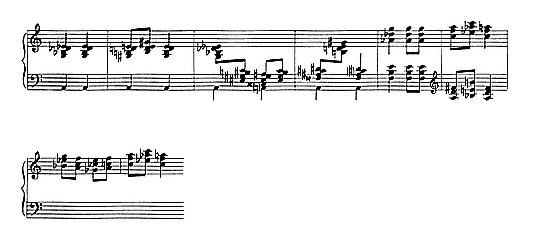
Example 59
in July, either before or after his visit with Nicolas Roerich, at which time the scenario and the titles of the dances were decided upon. Little could have been accomplished in August. The composer made trips to Karlsbad to settle the commission with Diaghilev, to Warsaw and Lugano to meet with Alexandre Benois, and finally to Berlin to visit his publisher, Russischer Musik Verlag, on matters pertaining to Petrushka . In fact, Craft estimates that the initial notations for the "Augurs of Spring" were entered after the composer's return from Berlin, on or around September 2.[10]
In a letter to Roerich dated September 26, 1911, Stravinsky informed his collaborator of his new address in Clarens, Switzerland, explaining that he had already begun to compose a dance, his description of which fits the "Augurs" movement.[11] Yet it is entirely possible—indeed probable, as suggested—that these sketches were preceded not only by considerable improvisation (both at and away from the piano), but by additional sketch material as well. The existence of sketches as much as a year earlier is confirmed by two letters from Stravinsky to Roerich dated July 2, 1910, and August 9, 1910.[12] And Craft has published what he believes to be the earliest extant sketch for The Rite : pre-dating the sketchbook, and given here as Example 59, it shows an E

[10] Vera Stravinsky and Robert Craft, Stravinsky in Pictures and Documents (New York: Simon and Schuster, 1978), p. 596.
[11] "Letters to Nicholas Roerich and N. F. Findeizen," Appendix II in the accompanying booklet to Stravinsky, The Rite of Spring: Sketches 1911–1913 .
[12] Ibid., pp. 27–29.
[13] V. Stravinsky and Craft, Stravinsky in Pictures and Documents , p. 597.
other words, the order of the entries on page 3, even if authentic, in no way discounts the possibility that the motto chord of the fourth line might indeed have been the composer's first idea.
But how significant is the which-came-first argument? Can it matter all that much whether, as Craft now claims, the motto chord of the fourth line was derived from the D






Clearly the essentials here are: (1) that the notations for the "Augurs of Spring" on pages 3 and 4 of the sketchbook, whether in their most original form or not, probably represent the composer's earliest ideas for The Rite ; and (2) that these ideas, forming the very cornerstone of The Rite , introduce vertical and linear arrangements that are of paramount concern not only to a consideration of the "Augurs of Spring" but of succeeding movements as well. Regardless of which came first, the chord or its melodic conception, these arrangements are central to our analytic-theoretical perspective.
1. The three pitches of the D





2. The disengagement from the motto chord of E










3. Vertical or linear in conception, the superimposed quality of the configuration points in turn to the essential triadic makeup of the harmony in these initial pages.
4. Apart from arpeggios, melody is represented most prominently by the (B



[14] Igor Stravinsky and Robert Craft, Expositions and Developments (Berkeley: University of California Press, 1981), p. 141.
terval order 2-1-2 (whole step-half step-whole step) and with a pitch numbering of (0 2 3 5). The D







5. The (C E G) triad, substituting occasionally for (E G






6. The outer pitches of the motto chord, E

And so pages 3 and 4 of the sketchbook introduce groupings or arrangements central to the "Augurs" movement and to the work as a whole: the vocabulary of The Rite consists in large part of 0–2 whole-step reiterations, (0 2 3 5) tetrachords, major and minor triads, dominant-seventh chords, and 0–11 or major-seventh vertical interval spans. (Again, as in earlier chapters, conventional terminology is employed for purposes of identification, with no intention of invoking tonally functional relations.) And although, given the reputation of this piece as one of considerable complexity, this reduction might seem a bit fanciful, we can narrow the scheme somewhat. The (0 2 3 5) tetrachord, as the principal melodic fragment not only of The Rite but of Stravinsky's "Russian" period generally, surfaces by way of all manner of reiterating, folkish tunes. As such, it is invariably articulated in the tightest or closest arrangement, confined to the interval of 5, the fourth (without interval complementation, in other words). It may nonetheless be either (0 2 5) or (0 3 5), incomplete, as noted already, with the D







The triads and dominant sevenths also assume a characteristic disposition: as with the (0 2 3 5) tetrachord, the tight or close arrangement. This is not always the case but is customary, especially in the treble registers. The typical dominant-seventh placement is exemplified by the top half of the motto chord: closed position, "first inversion." Starting with the chord's E

By contrast, the 0–11 vertical span is rarely melodic in character (fragmental or
linear), but defines, harmonically or vertically, the span between pitches of unmistakable priority among superimposed, reiterating fragments or chords. Thus, as noted above, the E














Example 60
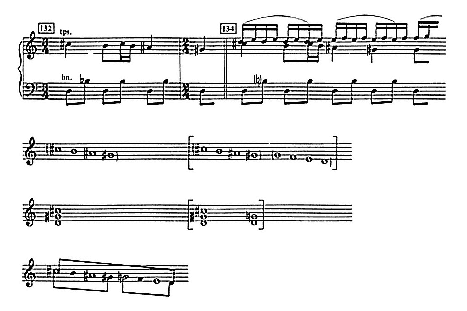
Example 61:
"Ritual Action of the Ancestors"
motto chord at no. 13, note the metric accentuation of the 0–11 span in these illustrations, an accentuation that typifies its articulation throughout The Rite , rendering it highly conspicuous from one block or movement to the next.